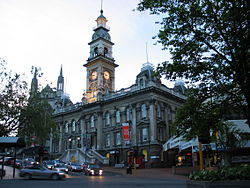
In local government, a city hall, town hall, civic centre, guildhall, or municipal building is the chief administrative building of a city, town, or other municipality. It usually houses the city or town council, its associated departments, and their employees. It also usually functions as the base of the mayor of a city, town, borough, county or shire, and of the executive arm of the municipality.
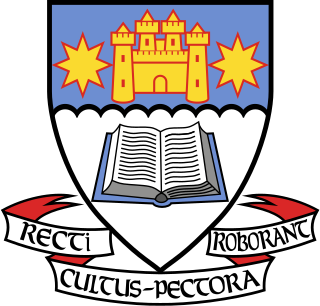
Otago Boys' High School (OBHS) is a secondary school in Dunedin, New Zealand. It is one of New Zealand's oldest boys' secondary schools. Originally known as Dunedin High School, it was founded on 3 August 1863 and moved to its present site in 1885. The main building was designed by Robert Lawson and is regarded as one of the finest Gothic revival structures in the country. Situated on high ground above central Dunedin it commands excellent views of the city and is a prominent landmark.

Municipal Auditorium is a multi-purpose facility located in Kansas City, Missouri. It opened in 1935 and features Streamline Moderne and Art Deco architecture and architectural details.

George Street is the main street of Dunedin, the second largest city in the South Island of New Zealand. It runs for two and a half kilometres north-northeast from The Octagon in the city centre to the foot of Pine Hill. It is straight and undulates gently as it skirts the edge of the hills to its northwest. South of The Octagon, Princes Street continues the line of George Street south-southwest for two kilometres.

First Church is a prominent church in the New Zealand city of Dunedin. It is located in the heart of the city on Moray Place, 100 metres to the south of the city centre. The church is the city's primary Presbyterian church. The building is regarded as the most impressive of New Zealand's nineteenth-century churches, and is listed by Heritage New Zealand as a Category I structure.

The Octagon is the city centre of Dunedin, in the South Island of New Zealand. It is an eight-sided plaza with a circular one-way carriageway, bisected by the city's main street, and is also the central terminus of two other main thoroughfares. The Octagon is predominantly a pedestrian reserve, with grass and paved features, and is surmounted by a statue of the Scottish poet Robert Burns. Several of Dunedin's significant buildings and institutions adjoin the plaza, which is also a major hub for public transport in Dunedin, primarily taxi services.

Princes Street is a major street in Dunedin, the second largest city in the South Island of New Zealand. It runs south-southwest for two kilometres from The Octagon in the city centre to the Oval sports ground, close to the city's Southern Cemetery. North of The Octagon, George Street continues the line of Princes Street north-northeast for two and a half kilometres. Princes Street is straight but undulating, skirting the edge of the City Rise to its northwest. The part of the street immediately below The Octagon is the steepest section, as the road traverses an old cutting through Bell Hill.

Moray Place is an octagonal street which surrounds the city centre of Dunedin, Otago, New Zealand. The street is intersected by Stuart Street, Princes Street and George Street. Like many streets in Dunedin, it is named for a street in the Scottish capital Edinburgh.

The University of Otago Registry Building, also known as the Clocktower Building, is a Victorian and later structure in the city of Dunedin, New Zealand. It stands next to the banks of the Water of Leith and is constructed from contrasting dark Leith Valley basalt and Oamaru stone, with a foundation of Port Chalmers breccia. The building houses the administrative centre of the university, and the office of the Vice-Chancellor. It has a Category I listing with Heritage New Zealand.

The Regent Theatre is a theatre in Dunedin, New Zealand with a seating capacity of about 1,650. It is in The Octagon, the city's central plaza, directly opposite the Municipal Chambers and close to the Dunedin Public Art Gallery.

The Dunedin Public Art Gallery holds the main public art collection of the city of Dunedin, New Zealand. Located in The Octagon in the heart of the city, it is close to the city's public library, Dunedin Town Hall, and other facilities such as the Regent Theatre.

Robert Arthur Lawson was one of New Zealand's pre-eminent 19th century architects. The Dictionary of New Zealand Biography states that he did more than any other designer to shape the face of the Victorian era architecture of the city of Dunedin. He is the architect of over forty churches, including Dunedin's First Church for which he is best remembered, but also other buildings, such as Larnach Castle, a country house, with which he is also associated.

Stuart Street is one of the main streets of Dunedin, New Zealand. As with many of Dunedin's streets, it is named after a main street in Edinburgh, Scotland.
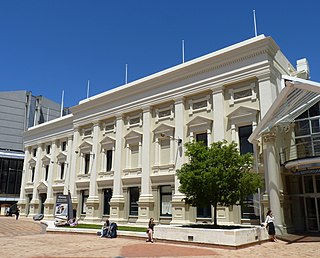
The Wellington Town Hall is a concert hall and part of the municipal complex in Wellington, New Zealand, which opened in December 1904. It has been closed to the public since the 2013 Seddon earthquake for extensive strengthening work, and is projected to reopen in 2027.
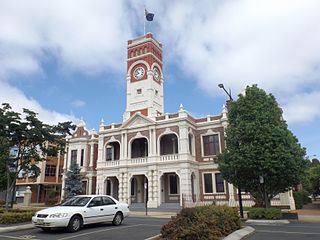
Toowoomba City Hall is a heritage-listed town hall at 541 Ruthven Street, Toowoomba, Toowoomba Region, Queensland, Australia. It was designed by Willoughby Powell and built in 1900 by Alexander Mayne. It is also known as Toowoomba Town Hall. It was added to the Queensland Heritage Register on 21 October 1992.

Gladstone Regional Art Gallery and Museum is a heritage-listed former town hall and now art gallery and museum at 144 Goondoon Street, Gladstone, Gladstone Region, Queensland, Australia. It was designed by Roy Chipps and built from 1933 to 1934 by relief workers. It is also known as Gladstone Town Hall & Council Chambers. It was added to the Queensland Heritage Register on 7 July 1998.

This list of works by Robert Lawson categorises and provides brief details of the structures designed by Scottish-born architect Robert A. Lawson (1833–1902) who is said did more than any other designer to shape the face of the Victorian era architecture of the city of Dunedin.
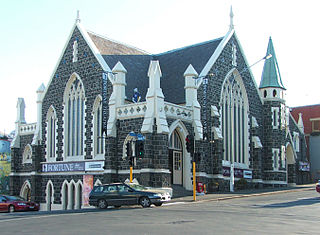
The former Trinity Methodist Church is registered as a category I historic place by Heritage New Zealand, which recognises its historic and architectural significance. Originally a Methodist church, it is located on the corner of Moray Place and Upper Stuart Street, in the heart of the southern city of Dunedin. In 1977 the church was refitted and operated as the Fortune Theatre.

St Andrew's Presbyterian Church was a prominent church in Dunedin, New Zealand. Designed by pre-eminent Dunedin Robert Lawson it was constructed in 1870 to serve a rapidly developing area of the city which became notorious for its slum housing, poverty and crime which led to it being referred to as the "Devil's Half-Acre" from 1873 onwards. The church is best known for its long time crusading minister the Reverend Rutherford Waddell. Waddell's 'Sin of Cheapness' sermon which was a landmark in New Zealand's social and labour history was delivered from its pulpit. It eventually closed as a place of Presbyterian worship in 1978 and after briefly serving as a place of worship for the Word of Life Pentecostal Church it was purchased by the Coptic Orthodox Church in 2000, who renamed it the Archangel Michael Coptic Orthodox Church.
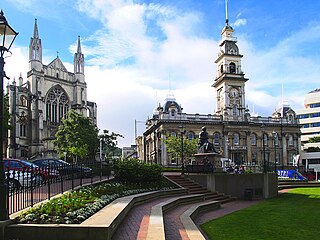
Central Dunedin is the central suburb and business district of the New Zealand city of Dunedin.
